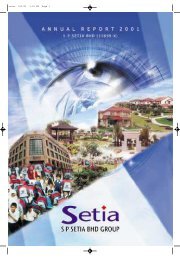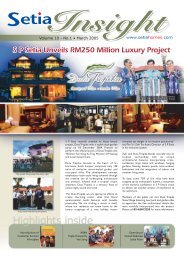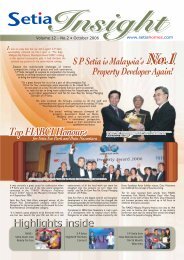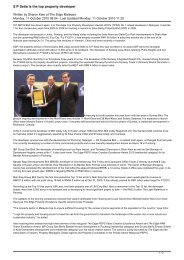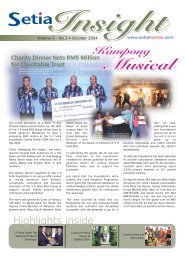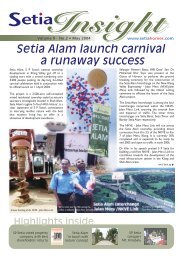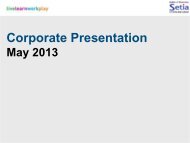Change - S P Setia Berhad
Change - S P Setia Berhad
Change - S P Setia Berhad
You also want an ePaper? Increase the reach of your titles
YUMPU automatically turns print PDFs into web optimized ePapers that Google loves.
94<br />
Annual report 2008<br />
NOTES TO THE FINANCIAL STATEMENTS<br />
FOR THE YEAR ENDED 31 OCTOBER 2008<br />
1. SIGNIFICANT ACCOUNTING POLICIES (cont’d)<br />
(w)<br />
Employee benefits (cont’d)<br />
(iii)<br />
Share-based payment transactions<br />
The Group operates an equity-settled share-based compensation plan for its employees. The fair value of share options<br />
granted to employees is recognised as an employee cost over the vesting period with a corresponding increase in the<br />
share option reserve within equity.<br />
The amount to be expensed over the vesting period is determined by reference to the fair value of the share options<br />
at the date of the grant. The fair value of the share option is computed using the binomial model.<br />
The fair value of share options recognised in the share option reserve is transferred to share premium when the share<br />
option is exercised, or transferred directly to unappropriated profit when the share option expires or lapses.<br />
(x)<br />
Borrowing costs<br />
Borrowing costs incurred on assets under development that take a substantial period of time for completion are capitalised<br />
into the carrying value of the assets. Capitalisation of borrowing costs ceases when that assets are completed or during<br />
extended periods when active development is interrupted.<br />
All other borrowing costs are charged to the income statement in the period in which they are incurred. The interest<br />
component of hire purchase payments is charged to the income statement over the hire purchase period so as to give a<br />
constant periodic rate of interest on the remaining tenure of the hire purchase liabilities.<br />
(y)<br />
Taxation<br />
The tax expense in the income statement represents the aggregate amount of current tax and deferred tax included in the<br />
determination of profit or loss for the financial year.<br />
On the balance sheet, a deferred tax liability is recognised for taxable temporary differences while a deferred tax asset is<br />
recognised for deductible temporary differences and unutilised tax losses only to the extent that it is probable that taxable<br />
profit will be available in future against which the deductible temporary differences and tax losses can be utilised.<br />
No deferred tax is recognised for temporary differences arising from the initial recognition of:<br />
(i)<br />
(ii)<br />
goodwill, or<br />
an asset or liability which is not a business combination and at the time of the transaction, affects neither accounting<br />
profit nor taxable profit.<br />
Deferred tax assets and liabilities are measured based on tax consequences that would follow from the manner in which<br />
the asset or liability is expected to be recovered or settled, and based on tax rates enacted or substantively enacted by the<br />
balance sheet date that are expected to apply to the period when the asset is realised or when the liability is settled.<br />
Current tax and deferred tax are charged or credited directly to equity if the tax relates to items that are credited or charged,<br />
whether in the same or a different period, directly to equity.<br />
(z)<br />
Cash equivalents<br />
Cash equivalents are short term, highly liquid investments that are readily convertible to known amounts of cash and which<br />
are subject to insignificant risk of changes in value.<br />
For the purposes of the cash flow statements, cash and cash equivalents are presented net of bank overdrafts and exclude<br />
fixed deposits, sinking fund accounts and escrow accounts pledged to secure banking facilities.








